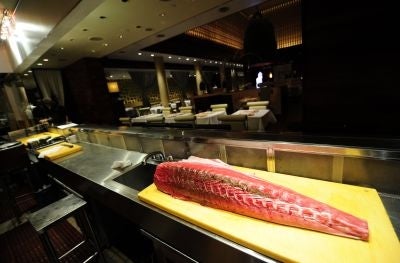In sushi bars, tuna vanishes bite by bite

Your support helps us to tell the story
From reproductive rights to climate change to Big Tech, The Independent is on the ground when the story is developing. Whether it's investigating the financials of Elon Musk's pro-Trump PAC or producing our latest documentary, 'The A Word', which shines a light on the American women fighting for reproductive rights, we know how important it is to parse out the facts from the messaging.
At such a critical moment in US history, we need reporters on the ground. Your donation allows us to keep sending journalists to speak to both sides of the story.
The Independent is trusted by Americans across the entire political spectrum. And unlike many other quality news outlets, we choose not to lock Americans out of our reporting and analysis with paywalls. We believe quality journalism should be available to everyone, paid for by those who can afford it.
Your support makes all the difference.As chefs at the upscale New York sushi restaurant Megu slide huge knives through their latest bluefin tuna, the possible extinction of the species is far from their minds.
Only the fatty underbelly of the fish has their attention - the white, marbled "otoro" section that tastes like butter and sells at 16 dollars for a morsel smaller than a mobile phone.
"It's what people who really like tuna always ask for," chef Zenon Xochmitl says.
That frenzy for "otoro," the slightly pinker, leaner "chutoro" and classic red "akami" is also what many countries attending this week's CITES conference on endangered wildlife fear is pushing the entire Atlantic bluefin species toward annihilation.
Sushi and sashimi portions are tiny, but the cuisine is so popular in Japan, and increasingly around the world, that diners are literally wiping out the bluefin a bite at a time, marine ecologists say.
"People think of fish as food, not as a species, not as wildlife," said Susan Lieberman at the Pew Environmental Group in Washington. "We have the attitude that the resources of the oceans are limitless, but they're not."
To feed that appetite, global fishing fleets vacuum up entire schools of bluefin, leaving only empty water in their wake.
The ocean-roving fish, which can grow to more than four meters (13 feet) in length, sell for fortunes. A 233-kilogram (512-pound) bluefin fetched 176,000 dollars at a Tokyo auction in January.
The supply network is as extravagant as the cuisine is luxurious. Freshly caught bluefins routinely jet worldwide before ending up in tiny pieces between a pair of chopsticks.
The fish served at Megu had been caught off Greece, flown to Japan, then flown again, already gutted, in a long cardboard box inscribed "Megu" to New York's JFK airport.
Koichi Yokoyama, president of the Megu chain, has no doubt the effort is worth it.
"In Japan, the bluefin tuna is prized as the best," he said, standing alongside a slowly melting Buddha ice statue in the center of the restaurant. Bluefin is "king."
The CITES conference in Doha is considering banning international bluefin trade. That would turn the supply chain upside down and probably allow the fish population to pull back from the brink.
Japan threatens to ignore the ban, but environmentalists believe the sushi machine, as it exists today, would grind to a halt.
"Japan would have to comply. Japanese companies, I feel, would go along with international law. Can you imagine the airlines that carry this stuff not going along? Of course they would," said Charles Clover, author of "The End of the Line," a book about tuna fishing that was recently turned into a documentary.
For now, there is little sign of retreat in the sushi sector.
The Nobu chain, co-owned by actor Robert De Niro, continues to serve the endangered fish, despite being targeted by environmentally-minded celebrities such as Elle Macpherson and Sting.
Meanwhile, Megu plans to open a new restaurant in Russia this year, followed by outlets in New Delhi, Qatar and Mumbai.
And at the other end of the scale, New York-based pharmacy chain Duane Reade has just started selling sushi - albeit not with bluefin - alongside its usual stock of shampoos and toilet rolls.
"Sushi is one of the most basic types of food eaten in America today," said Tim Zagat, co-founder of the Zagat restaurant guides. "It's all over the country, an example of how a foreign approach to food can be taken over and become almost American."
Yokoyama acknowledges restaurants like Megu are part of the problem, but says pollution and other non-fishing related issues are also to blame.
Megu even tried experimenting with a farmed bluefin tuna from Japan called kindai but had to stop because of difficulty in ensuring supplies, he said.
Ordinary diners who would be aghast at finding whale or tiger on the menu are not helping either.
But that's largely because of ignorance, Zagat said.
"It's not that they've ignored the problem, it's that it has not been in their face," he said.
"When they go to a sushi bar they are not looking at a bluefin tuna. They are looking at a little piece of reddish flesh. There's no big sign saying, 'endangered tuna.'"
Should bluefin be banned from international trade, most restaurants would have to switch to less prized forms of tuna, such as yellow fin or bigeye - although these too are under growing pressure.
Yokoyama envisions a more radical response: abandoning this traditional delicacy altogether.
"If that's the situation, we'd probably take it off the menu," he said.
"We would not want to serve other tuna if it wasn't bluefin."
Join our commenting forum
Join thought-provoking conversations, follow other Independent readers and see their replies
Comments